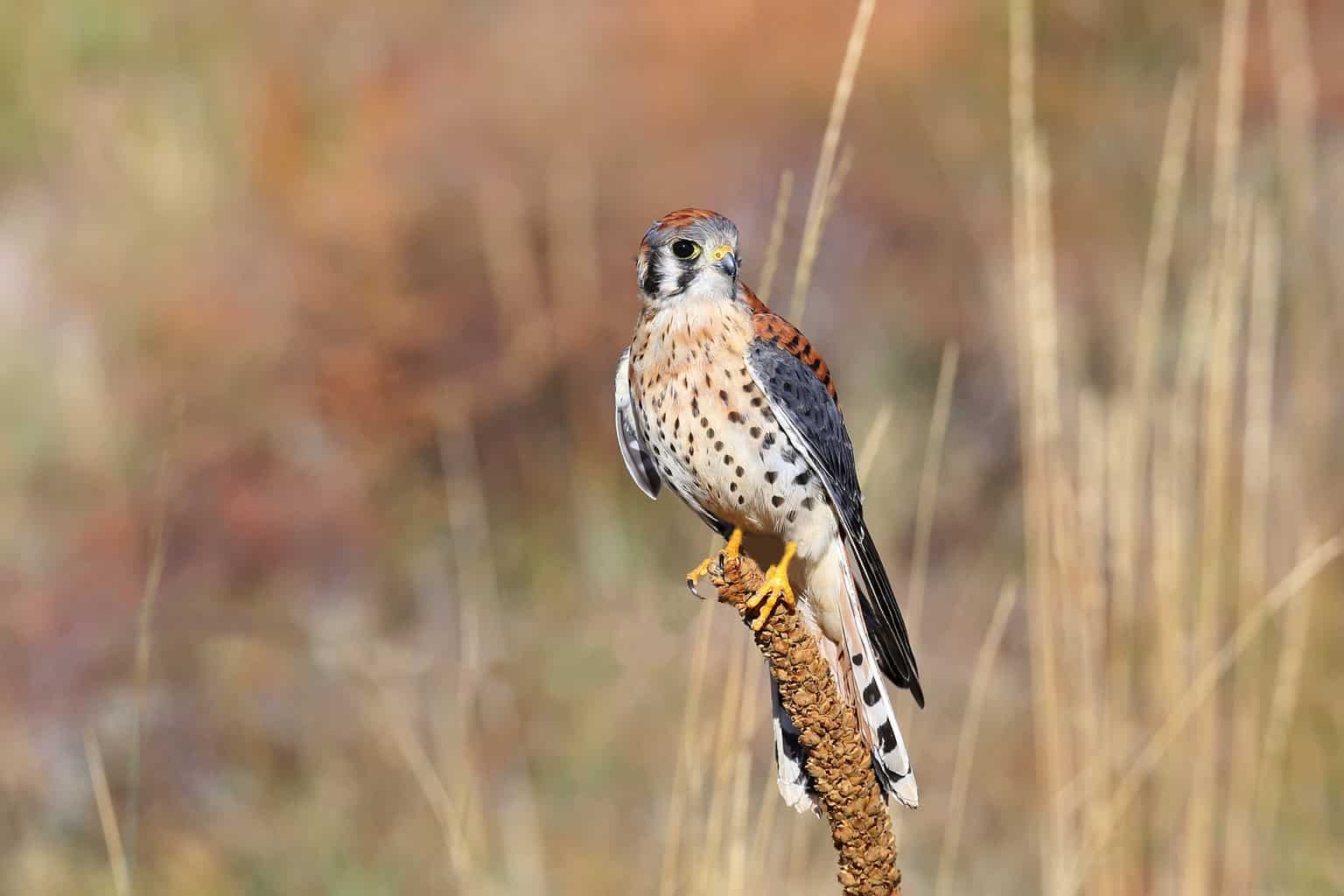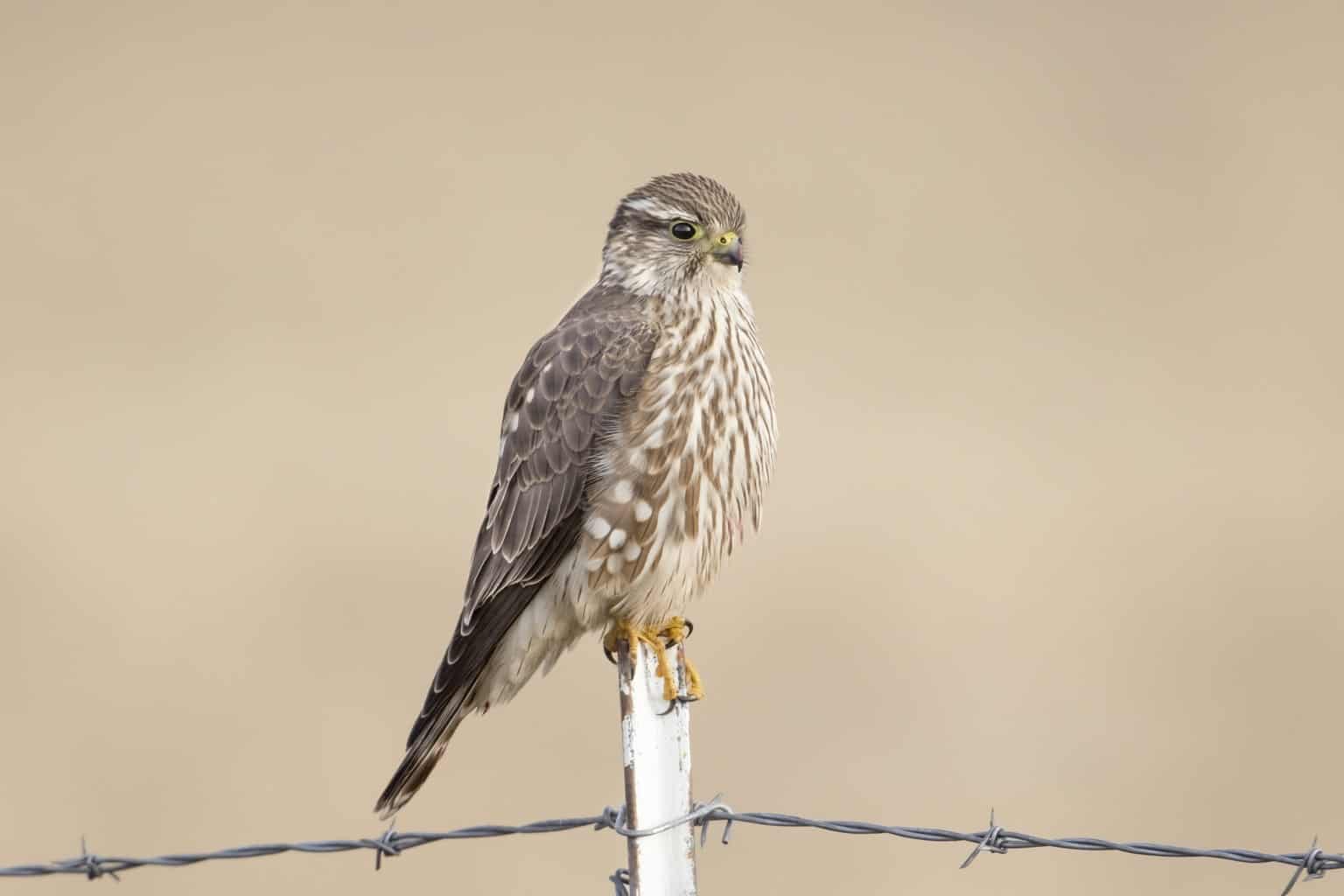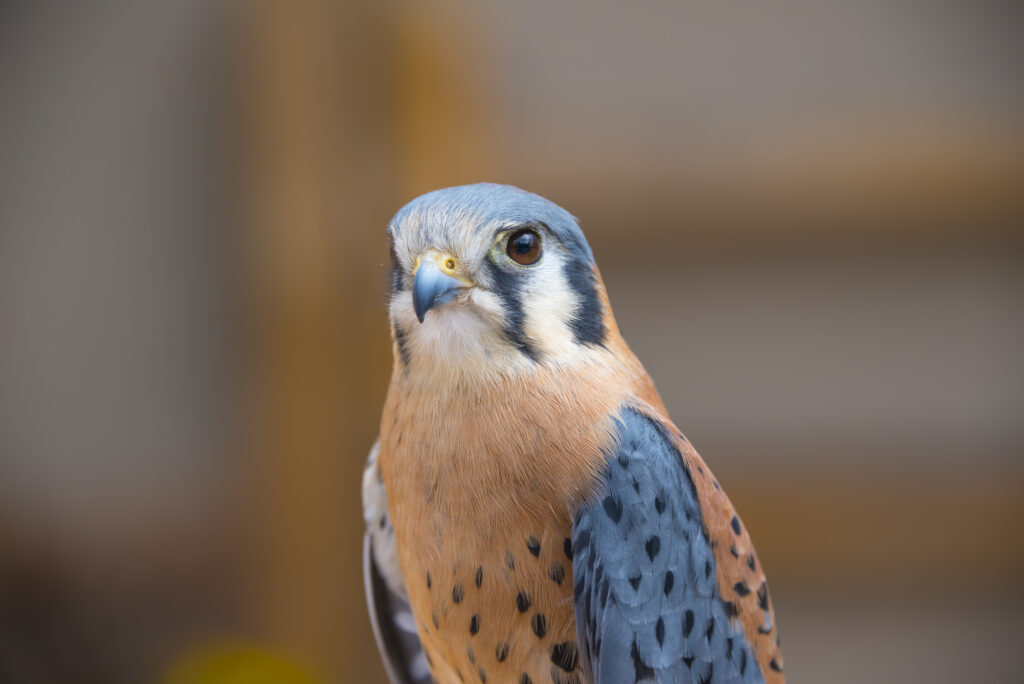Ranging from smooth plains to rolling hills, Indiana is a falcon’s dream come true. It’s also a birder’s dream come true since you can spot 5 different falcon species here!
Falcons need plenty of space to survey the land for predators or potential prey. Indiana’s flatter landscape is fitting for several of these bird species, not to mention its brilliantly hot summers.
Whether you live in Indiana or want to swing by on vacation, I’ll help you successfully spot multiple falcon species. By the end of this article, you’ll be knowledgeable on these birds of prey’s behavior and will even have a few birding locations to check out!
Peregrine Falcon

- Species Name: Falco peregrinus
- Weight: 330 grams to 1,500 grams
- Length: 34 cm to 58 cm
- Wingspan: 29 cm to 47 cm
The peregrine falcon is impossible to overlook, whether literally or culturally. This majestic bird is capable of immense speed over 200 miles per hour, making it the fastest animal in the world.
Appearance
These birds are gorgeous with their dark gray wings, dark heads, and barred stomachs. They have vivid yellow legs, a yellow beak, and a yellow rim around their eyes.
A common feature among falcons is very little sexual dimorphism when it comes to plumage (or visual differences between sexes). However, female falcons tend to be larger than males – this is true for peregrine falcon females who are twice as large as males.
Range
If you want to spot one of these brilliant falcons in the wild, time your birdwatching expedition during late summer and early fall. Peregrine falcons are most common in Indiana during their migration season.
If you’re lucky, you may even spot a few lingering populations during spring and winter.
Peregrine falcons generally enjoy hunting near bodies of water such as lakes and rivers. However, they’re increasingly spotted near urban areas – city birders may just see one swooping after prey on the outskirts.
Diet
Peregrine falcons much prefer to hunt other bird species. Some of their favorite birds to pursue are ptarmigans, ducks, pigeons, and songbirds.
However, they’re adaptable and will sometimes switch to bats or the occasional fish when they need to.
Birdcall
Peregrine falcons aren’t quite as chatty as other falcons, sometimes letting out swooping wails and other times low, hoarse kek-kek-kek patterns.
Fun Fact
Peregrine falcons are so adaptable they can be found in nearly every habitat you can think of. Snowy, mountainous, islands, cities, you name it!
American Kestrel

- Species Name: Falco Sparverius
- Weight: 80 grams to 165 grams
- Length: 22 cm to 31 cm
- Wingspan: 51 to 61 cm
Ah, we arrive at one of my favorite bird species ever! The American Kestrel is an absolute delight to behold for its vibrant plumage and tiny size.
Appearance
It’s impossible to mix up the American Kestrel with other bird species. Males have breathtaking cinnamon-brown backs, gray-blue wings, barred stomachs, and striped tails.
Their face almost looks like a cheetah’s. They have long black facial markings and a dainty, tiny yellow beak.
Female American Kestrels are also stunning with a little more brown and a little less blue. She also has a little more barring on her wings and stomach.
Range
I highly recommend scoping out these fierce falcons if you have less experience or if you’re low on time during your visit. These birds are one of the easiest to spot in Indiana since they show up year-round, being particularly common in spring and fall.
American Kestrels, much like the peregrine falcon, also enjoy a variety of environments. However, they tend to prefer more spacious areas such as farmland, agricultural fields, meadows, and plains.
If you’re traveling through the state, you’ll likely see a few individual birds perched on fence posts.
Diet
A tiny bird needs a suitably tiny diet! American Kestrels tend to eat a variety of insects such as grasshoppers, dragonflies, and beetles.
Occasionally these falcons will hunt tiny mammals or lizards. They’re even known to eat a few scorpions when the mood strikes them.
Birdcall
American Kestrels always sound a little excited (and so would I if I were a gorgeous falcon). Expect to hear short, sharp kee-kee-kee or klee-klee patterns.
Fun Fact
Falcons have a reputation for flying solo, but American Kestrels occasionally hunt in groups to improve their chances of success.
Prairie Falcon

- Species Name: Falco mexicanus
- Weight: 500 grams to 970 grams
- Length: 38 cm to 45 cm
- Wingspan: 102 to 107 cm
Let’s switch to the other end of the birding equation! If you want a little more of a challenge, the prairie falcon is a solid starting point.
Appearance
The prairie falcon has soft and subtle coloration, covered in a dusty gray-brown with a white stomach covered in brown flecks. They have an interesting moustache-like marking around their yellow beak.
As is common with falcons, males and females look extremely similar – females are much larger and a little more bulky.
Range
This falcon species is considered accidental, so you won’t spot it easily. However, there have been a few sightings here and there throughout the state during the winter months.
As you can see with their name, their most suitable habitats are wide, spacious environments. Keep an eye out near plains, meadows, grasslands, deserts, and agricultural fields.
If you want to increase your chances of glimpsing a prairie falcon, check out the Somerville Mine. There are nearby public roads that cross over the location that tourists can visit.
Diet
Prairie falcons have a rather diverse diet that includes bird species, small mammals, lizards, and snakes. They’ll scan the ground for possible movement, then swoop in low and snatch their prey in a blink.
Birdcall
Prairie falcons sometimes let out kak-kak-kak cries, but other times a long, faint kwee-kwee-kwee.
Fun Fact
While the peregrine falcon (and the next bird on his list) is known for falconry, the prairie falcon is also very popular with falconers.
Merlin

- Species Name: Falco columbarius
- Weight: 125 grams to 300 grams
- Length: 24 cm to 33 cm
- Wingspan: 58 cm to 66 cm
Do you plan on birding during a freezing Indiana winter? You’re more likely to spot the merlin, a majestic little falcon with a fascinating array of plumage variations.
Appearance
Merlins are small falcons with a streamlined body, boasting large, dark eyes and a small beak. However, their adaptability has given them quite a few different colors to look out for.
- Black Merlin – these falcons are a dark gray-blue with a bright white stomach that’s covered in streaks
- Prairie Merlin – these merlins look quite different with a deep, dusty brown body and a bright stomach with heavy flecks
- Pacific Northwest Merlin – lastly, these variations are a very dark blue (almost black) with a bright white stomach
Range
These falcons are most common in the state during the winter months, but you may see small populations during fall and colder spring days.
Merlins are very flexible falcons that enjoy a variety of environments such as coastal areas, plains, and shrubby fields.
Diet
Since the merlin is a smaller falcon, they tend to hunt smaller prey. They’ll sometimes pursue small mammals, but other times eat insects.
Birdcall
These birds sound quite assertive, often letting out sharp chee-chee patterns.
Fun Fact
While falcons are known for long, slow glides, merlins often fly with quick, rapid wingbeats.
Gyrfalcon

- Species Name: Falco rusticolus
- Weight: 1,350 to 2,100 grams
- Length: 48 to 65 cm
- Wingspan: 110 to 160 cm
While this bird is very rare in Indiana, I couldn’t possibly leave it off the list. The gyrfalcon is truly a bird straight out of your wildest dreams.
Appearance
This massive, majestic falcon has a huge wingspan, a flared tail, and heavily feathered legs. They have four plumage variations (or morphs) you should know about.
- Black – this morph has a brown-black body with a spotted stomach and spotted head
- Brown – this one boasts a cream body and speckled stomach with brown wings
- White – these have a white body covered in dark speckles along the back and wings
- Silver – lastly, these have a silvery body with a light stomach and darker gray wings
Range
These magnificent birds are very rare in Indiana, so you’ll need to get lucky to spot one in the wild. Here’s a tip: a few have been spotted in the Kankakee Fishing & Wildlife Area.
The reason why these falcons rarely show up is because they prefer incredibly cold environments. They usually spend time in the Arctic, but will occasionally leave their range to visit coastlines or valleys.
Diet
These large falcons hunt suitably large prey such as rabbits, various bird species, and even arctic foxes. They’ll sometimes go after smaller prey such as songbirds.
Birdcall
Gyrfalcons may be striking to see, but have a more subtle birdcall. They sometimes let out low, gruff kak-kak patterns, but other times a long, sharp hee-hee-hee.
Fun Fact
Gyrfalcons aren’t fond of building their own nests, which is a common behavior with falcon species. They prefer to use old nests made by other birds, particularly other raptors.
Keep a Close Eye Out for These Fascinating Species in Indiana
Wherever you are in Indiana, you’re just a short trip away from a location where falcons are comfortable. However, if you want to boost your success rates for spotting these birds, you need to get comfortable with good timing.
Most of these species have very particular times they like to show up in the state, though American Kestrels show up year-round. The Somerville Mine’s nearby public roads and the Kankakee Fishing & Wildlife Area will increase your chances of spotting rare prairie falcons and gyrfalcons.
Want to learn more about spotting bird species in Indiana? Our guide on birds in Indiana will help you with doves, warblers, and more!

